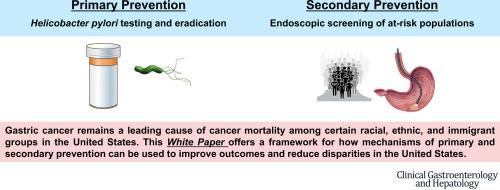Clinical Gastroenterology and Hepatology ( IF 11.6 ) Pub Date : 2021-10-06 , DOI: 10.1016/j.cgh.2021.09.039 Robert J Huang 1 , Meira Epplein 2 , Chisato Hamashima 3 , Il Ju Choi 4 , Eunjung Lee 5 , Dennis Deapen 5 , Yanghee Woo 6 , Thuy Tran 6 , Shailja C Shah 7 , John M Inadomi 8 , David A Greenwald 9 , Joo Ha Hwang 1

|
Background & Aims
Gastric cancer (GC) remains a leading cause of mortality among certain racial, ethnic, and immigrant groups in the United States (US). The majority of GCs are diagnosed at advanced stages, and overall survival remains poor. There exist no structured national strategies for GC prevention in the US.
Methods
On March 5–6, 2020 a summit of researchers, policy makers, public funders, and advocacy leaders was convened at Stanford University to address this critical healthcare disparity. After this summit, a writing group was formed to critically evaluate the effectiveness, potential benefits, and potential harms of methods of primary and secondary prevention through structured literature review. This article represents a consensus statement prepared by the writing group.
Results
The burden of GC is highly inequitably distributed in the US and disproportionately falls on Asian, African American, Hispanic, and American Indian/Alaskan Native populations. In randomized controlled trials, strategies of Helicobacter pylori testing and treatment have been demonstrated to reduce GC-specific mortality. In well-conducted observational and ecologic studies, strategies of endoscopic screening have been associated with reduced GC-specific mortality. Notably however, all randomized controlled trial data (for primary prevention) and the majority of observational data (for secondary prevention) are derived from non-US sources.
Conclusions
There exist substantial, high-quality data supporting GC prevention derived from international studies. There is an urgent need for cancer prevention trials focused on high-risk immigrant and minority populations in the US. The authors offer recommendations on how strategies of primary and secondary prevention can be applied to the heterogeneous US population.
中文翻译:

美国胃癌一级和二级预防的方法
背景与目标
胃癌 (GC) 仍然是美国 (US) 某些种族、民族和移民群体死亡的主要原因。大多数胃癌在晚期才被诊断出来,总体生存率仍然很低。美国尚无结构化的胃癌预防国家战略。
方法
2020 年 3 月 5 日至 6 日,研究人员、政策制定者、公共资助者和倡导领袖在斯坦福大学召开了一次峰会,以解决这一严重的医疗保健差距。这次峰会之后,成立了一个写作小组,通过结构化文献综述,批判性地评估一级和二级预防方法的有效性、潜在益处和潜在危害。本文代表了写作小组编写的共识声明。
结果
在美国,GC 的负担分布极不公平,并且不成比例地落在亚裔、非裔美国人、西班牙裔和美洲印第安人/阿拉斯加原住民身上。在随机对照试验中,幽门螺杆菌检测和治疗策略已被证明可以降低 GC 特异性死亡率。在进行良好的观察和生态研究中,内窥镜筛查策略与降低 GC 特异性死亡率相关。但值得注意的是,所有随机对照试验数据(用于一级预防)和大多数观察数据(用于二级预防)均来自非美国来源。
结论
国际研究中有大量、高质量的数据支持胃癌预防。迫切需要针对美国高风险移民和少数族裔进行癌症预防试验。作者就如何将一级和二级预防策略应用于美国的异质人群提出了建议。











































 京公网安备 11010802027423号
京公网安备 11010802027423号